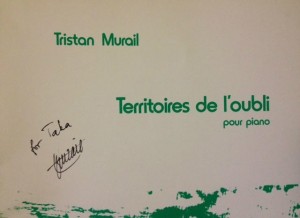Programs
Tristan Murail: Territoire de l'Oubli

"In Mr. Kigawa’s hands, they were investigations of the lives and deaths of sounds. As he moved through the program, you became increasingly sensitive to just how much of what you hear from a piano is a mysterious interplay of tones, sometimes long after the keys have been struck. So toward the end of 'Territories de l’Oubli' (1977), in which the sustaining pedal is held down throughout the piece’s nearly 30-minute duration, even the starkest, iciest notes have resonance, like the vapor rising from drops of liquid nitrogen… Mr. Kigawa plays with a fundamental gentleness, even in intense passage, but he brings a precision to the relentless pricks and bristling repetitions in these pieces…" - Zachary Woolfe, The New York Times
"Coming half an hour after an opening with a Debussyian watery flow, the slow fade of the final tone in 'Territoires de l’Oubli' recalled that moment at the end of 'Poissons d’Or.' Mr. Murail’s tones, some of them uncannily gonglike, cast off trails, whether in the form of natural resonance or written out as somber scales. Violent quivering, even pounding, on extremes of the piano yields peaceful decline in its aftermath." - Zachary Woolfe, The New York Times
"Tanaka’s teacher, the French spectralist composer Tristan Murail, wrote the second work of the night. Territoires de l’Oubli (‘Territories of Oblivion’) is a sprawling work written in 1977, built on the natural harmonic resonance of the piano. The work is a paradox, seeming for long periods locked in place, while in constant motion, transitioning imperceptibly from section to section. At times repeated patterns stand like statues, vast and cold in the central register of the piano while harmonies broil above and below. At others, only the extremes of the instrument are used, low and high passages rumbling and flashing. The ending uses a trick of physics to achieve incredible beauty, the final note pulsing gently as it fades.
Kigawa’s playing was impressive – it had to be – but as extraordinary as it was to watch his fingers dance across the rapid, complex passages, the delicacy of his playing was even more striking. In quiet moments, he summoned the merest ghosts of notes, tiny pinpricks just a half-step above silence." - Brendan Finan, The Journal of Music, IRELAND
"Coolly brilliant account" - Anthony Tommasini, The New York Times
"The philosophical element of the concert continued with the half-hour Tristan Murail Dominions of oblivion (Territoires de l'oubli.) If Debussy was creating music from an imaginary picture. Mr. Murail was conceptualizing a music without any reference to pictures inner or exterior. Not even reference to a piano!!!. By commanding the artist never take his foot off the sustaining pedal, he was saying that no single note could be a single note. That we had to listen to its overtones and undertones and notes before and beyond. The usual 'attacks' on the keys were 'scars on the continuum.' What did Mr. Kigawa produce in these 30 minutes? We heard repetitions both consonant and dissonant. Heartbeats of rhythms, along with thunder in the bass. Quintuple-fingering on a single note (Mr. Kigawa handled it as if playing Paganini on a Strad), we heard chaos and stability, one leading to the other, a seeming anarchy counterpointing to romantic Debussy-like filaments." - Harry Rolnick, Concerto.net